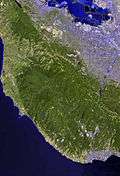Bear Creek (San Francisquito Creek)
| Bear Creek | |
| Arroyo de la Presa Bear Gulch Creek | |
| stream | |
 Bear Creek coming down from top of photo to join with Corte Madera Creek at bottom of photo, forming San Francisquito Creek. July 2011. | |
| Country | United States |
|---|---|
| State | California |
| Region | San Mateo County |
| Tributaries | |
| - left | West Union Creek, Dry Creek |
| City | Woodside, California |
| Source | Northeast slope of Sierra Morena, California a summit in the Sierra Morena portion of the Santa Cruz Mountains, near Kings Mountain, California |
| - location | Woodside |
| - elevation | 2,150 ft (655 m) |
| - coordinates | 37°25′09″N 122°19′09″W / 37.41917°N 122.31917°W [1] |
| Mouth | San Francisquito Creek |
| - location | Jasper Ridge Biological Preserve, Stanford University |
| - elevation | 256 ft (78 m) [1] |
| - coordinates | 37°24′36″N 122°14′18″W / 37.41000°N 122.23833°WCoordinates: 37°24′36″N 122°14′18″W / 37.41000°N 122.23833°W [1] |
Bear Creek, or Bear Gulch Creek, is a 6.6-mile-long (10.6 km)[2] southeastward-flowing stream originating north of the summit of Sierra Morena[3] in the Santa Cruz Mountains, near the community of Kings Mountain in San Mateo County, California, United States. It flows through the town of Woodside. Bear Creek and Corte Madera Creek join to become San Francisquito Creek in the Jasper Ridge Biological Preserve at Stanford University.[1][4]
History
The Spanish called the creek Arroyo de la Presa, meaning "creek of the dam", and it was part of the Rancho Cañada de Raymundo land grant.[5] A foreclosure sale in 1861 records, "Arroyo de la Presa, now called by the Americans Bear Gulch...which heads near the summit of the mountains (Sierra Morena)".[6] The Americans named Bear Creek Gulch for Mexican War veteran James "Grizzly" Ryder's near fatal encounter with the now extinct California grizzly bear (Ursus californicus).[7][8]
Ecology
In the Bear Creek sub-basin of the San Francisquito Creek watershed, adult steelhead (Oncorhynchus mykiss) migrate from the Bay to the freshwater streams of Bear, West Union, and Bear Gulch Creeks to spawn. They are listed as a threatened species under the Endangered Species Act. Steelhead smolt spend the first two years of their lives in freshwater, requiring perennial streams, or at least pools, to survive.[9] The anomalously low gradient of the channel of West Union Creek is also related to the fault and creates high quality steelhead habitat, as do the numerous seeps and springs along the fault. The permanent pools created by these seeps and springs are crucial to the survival of steelhead young.[10]
In a 2001 report thirty four barriers to trout migration were identified within Bear Creek and its West Union Creek, Bear Gulch, Squealer Gulch, and McGarvey Gulch tributaries.[9] That report identified the culvert for McGarvey Gulch creek at the Richards Road crossing in Huddart County Park as a significant migration barrier for adult and juvenile steelhead and was reconstructed with funds from the State Department of Transportation’s San Francisco Bay Salmonid Habitat Restoration Fund.[11]
Watershed
The Bear Creek mainstem is formed by the confluence of Bear Gulch Creek and West Union Creek near the intersection of Kings Mountain Road and Highway 84 in Woodside, California. The candelabra pattern of the numerous creeks and gulches that culminate in Bear Creek formed due to the motion of the San Andreas fault.[9] West Union Creek originates in the Phleger Estate, now part of the San Francisco State Fish and Game Refuge. The other Bear Creek tributaries flow through numerous additional public lands including Huddart County Park, Teague Hill Regional Open Space Preserve, and the northern edge of Wunderlich County Park. The Bear Creek watershed drains 13 square miles (34 km2).[4]
Water diverted from Bear Gulch is stored in a reservoir and provides as much as 50% of Woodside’s drinking water in the winter months.[10]
See also
References
- 1 2 3 4 "Bear Creek". Geographic Names Information System. United States Geological Survey.
- ↑ U.S. Geological Survey. National Hydrography Dataset high-resolution flowline data. "The National Map". Archived from the original on 2012-04-05., accessed March 15, 2011
- ↑ "Morena Sierra". Geographic Names Information System. United States Geological Survey.
- 1 2 Robert A. Leidy; Gordon S. Becker; Brett N. Harvey (2005). Historical Distribution and Current Status of Steelhead/Rainbow Trout (Oncorhynchus mykiss) in Streams of the San Francisco Estuary, California (PDF) (Report). Oakland, California: Center for Ecosystem Management and Restoration. Retrieved 2015-02-16.
- ↑ Roscoe D. Wyatt (1947). Historical Names and Places in San Mateo County. Redwood City, California: San Mateo County Title Company. p. 5.
- ↑ "Sheriff Sale". San Mateo County Gazette News. October 1861. Retrieved 2010-10-25.
- ↑ Erwin G. Gudde; William Bright (2004). California Place Names: The Origin and Etymology of Current Geographical Names. University of California Press. p. 30. ISBN 978-0-520-24217-3. Retrieved 2010-10-16.
- ↑ Grizzly Ryder; Cutler L. Bonestell (2009). A Woodside Reminiscence. BiblioLife. ISBN 978-1-113-31479-6. Retrieved 2010-10-16.
- 1 2 3 Jerry J. Smith; Deborah R. Harden (2001). Adult Steelhead Passage in the Bear Creek Watershed (PDF) (Report). San Francisquito Creek Watershed Council. Retrieved 2010-10-16.
- 1 2 "The Creeks that Flow through Woodside" (PDF). Bear Creek League of Advocates for the Watershed (Bear CLAW). Retrieved 2010-10-16.
- ↑ David G. Holland (2008-01-31). "Obstacle for Steelhead Trout Removed in San Mateo County's Huddart Park". San Mateo County. Retrieved 2010-10-16.
External links
- "San Francisquito CreekWatershed - Acterra".
- "San Francisquito Creek Watershed". prepared by the Oakland Museum of California
- "The Creeks that Flow through Woodside" (PDF). by the Bear Creek League of Advocates for the Watershed (Bear CLAW)
- Bear Creek Dam Removal for Steelhead Habitat Restoration
